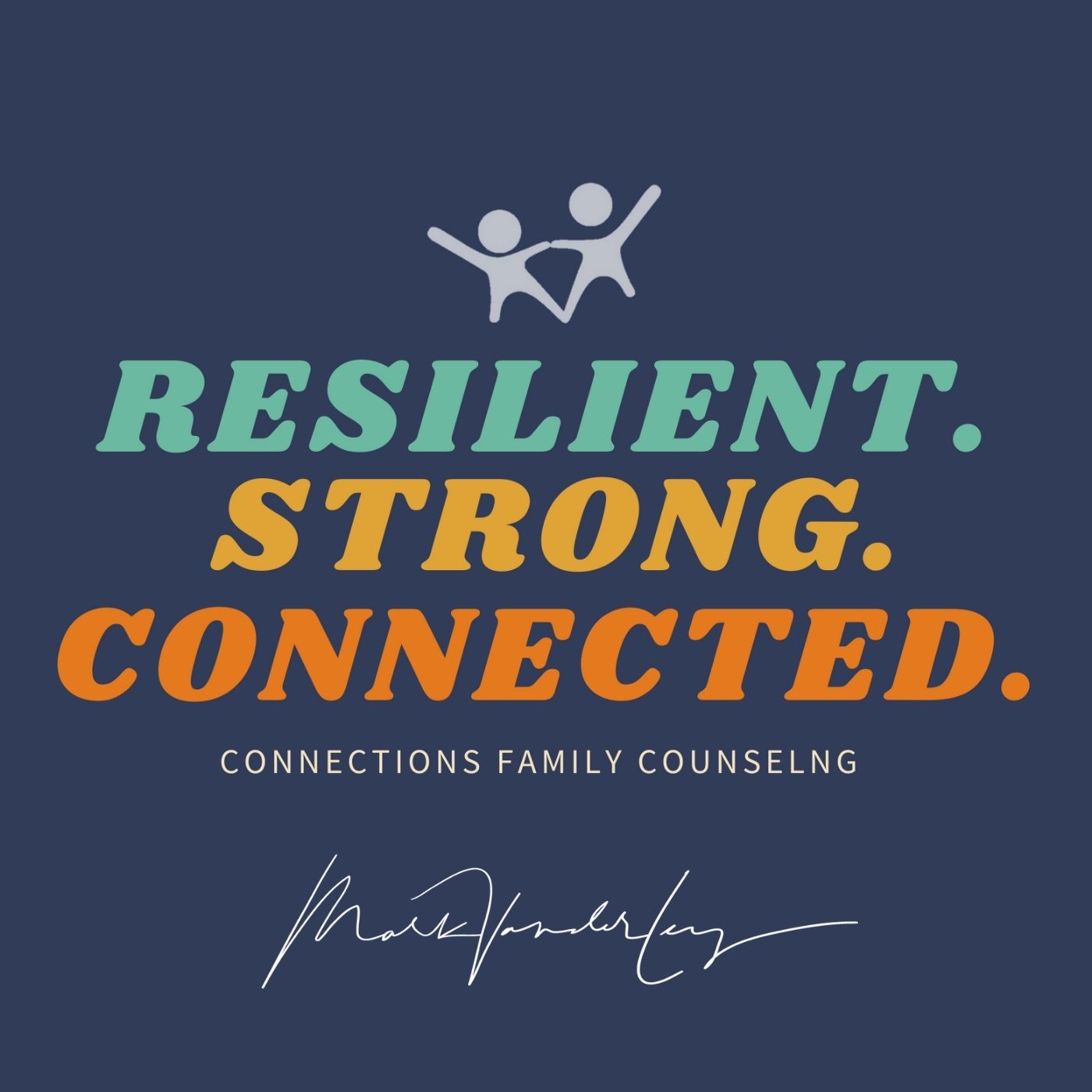Episodes
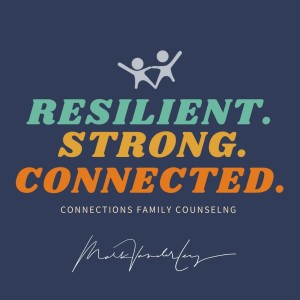
Friday Jan 21, 2022
A New Beginning: RESILIENT, STRONG, CONNECTED
Friday Jan 21, 2022
Friday Jan 21, 2022
I really like new beginnings. I look forward to the first day of class with each new semester. I recall the fun of an exciting new job, and I can feel the warmth of the first 40 degree day after a hard winter.
One of my favorite parts of being a counselor is the opportunity to offer someone the hope of a new beginning. People often seek out counseling in the lowest moments. They are desperate for help when they are hurt the most, at their lowest or have no other place to go.
But, to seek out counseling also demonstrates an incredible ability to hope. The first counseling session is full of hope that a new beginning is possible. Someone new to counseling may think, “I hope this counselor can help me”, “I hope things get better”, “I hope my marriage survives”, “I hope the negative thoughts stop”. What many find in this first session however, is that the most powerful aspect of counseling is the ‘WE’. It is discovered that by connecting with another caring and compassionate human ‘WE’ can find a path through the difficulty. The first counseling session begins a relationship in which you are no longer alone, you are now a ‘WE’ and have a partner to walk alongside you on the journey.
Connections Family Counseling’s mission is ‘to help build resilient kids, strong marriages, and connected families’ in Quincy, Illinois and the surrounding areas. Therefore, we believe that every new beginning starts with hope, is powered by ‘WE’ and becomes resilient, strong, connected. For this reason today is a new beginning for Connections Family Counseling. We are excited to announce that our podcast, which had been known as “the connected family podcast” will now be titled ‘Resilient, Strong, Connected” We believe that this name more clearly reflects the mission and vision of Connections Family Counseling and is therefore a better vehicle to assist our community members looking for a new beginning.
We hope that you will continue to benefit from the podcast and will join us in becoming ‘Resilient, Strong, Connected.
Visit Connections Family Counseling Website

Monday Nov 08, 2021
How To Teach Your Child About Boundaries with Christina Furnival, MS, LPCC
Monday Nov 08, 2021
Monday Nov 08, 2021
Christina Furnival, MS, LPCC is a wife, mom to two young children, licensed psychotherapist, writer, and children's book author. With over a decade of experience in the mental health field, she has worked in a variety of settings including a domestic violence center, hospital program, a non-profit providing parent support, education and coaching, outpatient clinics, and telehealth. Christina is passionate about supporting parents and children to understand themselves better, navigate challenges with confidence, and live the life they want.
Christina founded the internationally enjoyed blog, Real Life Mama, after going through postpartum depression and anxiety to support other moms going through the same thing.
Christina's writing has grown and evolved beyond her blog, enabling her to secure a children's book deal with PESI Publishing for an entire series focused on vital social-emotional skills.
Buy The Book Now By clicking Below
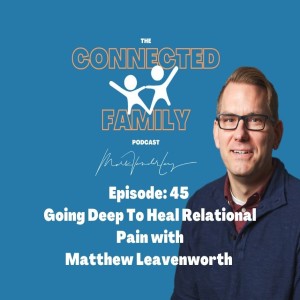
Thursday Jul 29, 2021
Going Deep To Heal Relational Pain With Matthew Leavenworth
Thursday Jul 29, 2021
Thursday Jul 29, 2021
Going Deep To Heal Relational Pain
Matthew Leavenworth is a mental health counselor in Billings Montana with Yellowstone Counseling Center. He graduated from Adams State University in 2015 with a master in mental health counseling and is currently pursuing his PhD at Adams State as a counselor educator. He has extensive experience seeing children, adults, couples, and families dealing with a range of disorders, including anxiety, depression, and trauma. He uses rock climbing as an experiential component of therapeutic healing and is an avid rock climber and outdoorsman when he is not home with his beloved wife Kylie and daughter Huxley.
The Dock
By Matthew Leavenworth
I feel the sand under my toes,
The sky is blue.
The sun is opaque behind thin clouds.
A slight breeze blows across the water.
The dock is a hundred yards in front of me,
A peninsula out into a great expanse of water.
I have a towel in my hands.
My skin goosepimples and I shiver as the breeze picks up with a chill.
I think about turning back.
The water is too cold.
The wind will chill me to the bone.
There are sharks out there.
Instead, I throw the towel aside and start forward.
My steps are heavy at first,
The wet sand swallows my feet,
I can still turn back.
I don’t.
I start jogging forward,
My quickening steps find the wooden planks, faster and faster.
There is no railing; only the sparkling cold and deep that will swallow me.
The end of the dock looms,
The thought occurs.
I can turn back,
I can stop unless I take another step.
I leap forward.
Into the open unknown.
The water swallows me.
It is all the pain and the triumph and everything I am.
I am deep under water.
Deeper and deeper,
Until I see.
Other shapes in the water, like mine, staring back at me, swimming also.
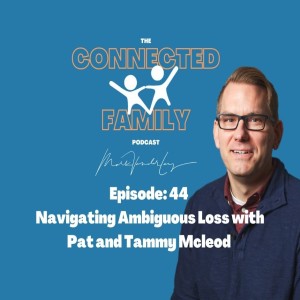
Sunday Apr 04, 2021
Navigating Ambiguous Loss with Pat and Tammy McCleod
Sunday Apr 04, 2021
Sunday Apr 04, 2021
Pat and Tammy McLeod serve as Harvard Chaplains for Cru, an interdenominational Christian ministry. Tammy is also the Director of College Ministry at Park Street Church in Boston. She received her MA in Spiritual Formation from Gordon-Conwell Theological Seminary. Pat holds an MA in Theological Studies from the International School of Theology and an MA in Science & Religion and a PhD in Practical Theology from Boston University. They are founding members of the Mamelodi Initiative in the township of Mamelodi, South Africa—a project that connects Harvard students with at-risk youth in a mentoring and educational program to prepare them for college. Pat and Tammy, certified instructors for Interpersonal Communication Programs, Inc., have been married for more than three decades and are parents to four grown children. They coauthored the book Hit Hard: One Family’s Journey of Letting Go of What Was and Learning to Live Well with What Is in which they share their journey into the world of ambiguous loss that began after their son suffered a traumatic brain injury playing football. Zach’s story received media coverage by ABC, NBC, CBS, and NPR. Recently they started COVID-19 Conversations on their website hoping to help others be resilient in ambiguous loss. For more information, please visit https://patandtammymcleod.com

Monday Feb 15, 2021
Connection Is The Cure
Monday Feb 15, 2021
Monday Feb 15, 2021
Connection is the Cure
If you are like me, sometimes you look around in your home, your community, and the world and feel overwhelmed by the pain. So many people are hurting. Children are stressed to the point of thinking about taking their own life. Parents struggle to respond when adolescents seem rebellious, angry, lost, and out of control. Married couples hurt one another over and over again with disagreements, harsh words, and thoughtless actions. These are only examples found inside families. Our communities and world also express pain through war, hatred toward the ‘other’, and social isolation. The pain seems overwhelming and constant.
I hope to be a person that assists with the healing of the world, I desire to help families recover from unimaginable hurt and to walk with couples as they grow to love one another again. I want to impact my community in a way that increases understanding and decreases social isolation. But how? What is the cure for the pain that so many experience?
I believe that healing occurs in the context of relationship. Parents overwhelmed by the difficult behaviors and strong emotions of their child need relationship. Couples caught in a dance of conflict desire to know and be known. Our communities racked by violence and hatred are desperate for an end to the isolation of being ‘the other’. In short, I believe that connection is the cure. The book “A General Theory of Love” (Lewis, Amini, & Lannon; 2000) describes the resonance, regulation, and revision that occurs in deep connection as the cure for relational and emotional pain.
Resonance:
Resonance is defined as “the reinforcement or prolongation of sound by reflection from a surface or by the synchronous vibration of a neighboring object.” When you strike a guitar string the vibration from that string causes the strings next to it to vibrate. Even more, if the two strings are vibrating at the same speed they are said to be in resonance and they amplify or reinforce one another. Humans are constantly broadcasting signals about what is happening inside of them (Lewis, Amini & Lannon; 2000). As our inner world is broadcast we long for another to recognize our signals and synchronously reflect our experience. Synchronous reflection amplifies and reinforces our internal state. The amplification and reinforcement of our internal state allow us to experience the sensation of being known and knowing the other (Lewis, Amini, & Lannon; 2000).
Regulation:
The broadcasting and synchronous reflection of experience allows an individual to be known and to know another. This connection of two beings establishes a physiological rhythm resulting in the modulation of emotions (Lewis, Amini, & Lannon; 2000). When distressed we instinctively look for others to help modulate overwhelming feelings. We seek out support groups, friends, partners, pets, or service providers (therapists, doctors, etc…) to regulate our physiology. Lewis, Amini, & Lannon argue that learning to modulate emotions is not learned through didactic or cognitive learning but only through experience (2000). “They absorb the skill from living in the presence of an adept external modulator, and they learn it implicitly” (Lewis, Amini, & Lannon; 2000; p. 171).
Revision:
Regulation is the process of implicitly learning to modulate emotion in connection with another. Revision is the process of rewiring the brains relational pathways to create more fulfilling relationships (Lewis, Amini, & Lannon; 2000). Our relational pathways are shaped early in life through the previously described processes of resonance and regulation. Hundreds probably thousands of early experiences form our templates of relating to self, others, and the world (Bowlby, 1969). Often, these early ways of relating do not lead to fulfilling relationships. Revising these templates requires many interactions with another in new more fulfilling ways. Like the process of regulation, revision is best caught rather than taught. It is the experience of a new relational pattern that changes the brain for good (Lewis, Amini, & Lannon; 2000).
Connection
The cure for relational and emotional pain is connection. Connection is synchronous reflection of experience, the modulation of emotions with another, and the revising of relational neuropathways through experience. Healing through connection is incredible news, it means that we all have the ability to help our loved ones heal. We all have the ability to connect, it is hard work, and it will require revision of our own, but it can be done.
References:
Bowlby, J. (1969). Attachment and loss: Attachment (Vol. 1) New York, NY: Basic Books.
Lewis, T., Amini, F., Lannon, R., (2000). A General Theory of Love. New York, NY: Vintage Books.
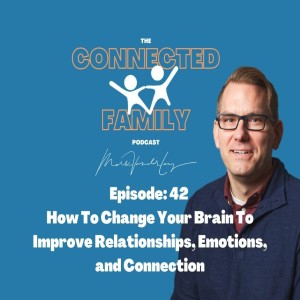
Sunday Feb 07, 2021
How to Change Your Brain To Improve Relationships, Emotions, and Connection
Sunday Feb 07, 2021
Sunday Feb 07, 2021
How to Change Your Brain To Improve Relationships, Emotions, and Connection.
This time of year, many of us are wondering how to change bad habits. Others plan out ways to accomplish big goals for the year. We may take big ideas and break them down into small steps or we may subscribe to a “Guru’s” fool proof way to “rock out 2019”. I recently read a book that argued the way to change yourself is to change your brain. What? Change my brain how does this work? Would I have to crack my head open and perform a lobotomy? Well, no. Curt Thompson in his book “Anatomy of the Soul” outlines the ways in which we change our relationships by changing our brain.
How to change:
Neuroscientists say that the brain is “plastic” meaning it can change and grow over the entire lifespan. So, Thompson states that we can use the “neuro-plastic triad” to change the way that we function in the relationships, ourself, and the world. He argues that we increase our functioning in relationships, emotion, and memory through aerobic activity, focused attention exercises and novel learning experiences.
Aerobic Activity:
We have always known that exercise is good for us. Most however tend to think of physical exercise as something that changes only our body. We may lose a few pounds, gain more physical strength, or fit into the clothes we wore in our younger days. Thompson argues however that regular vigorous activity actually changes our brain and makes it more responsive for our lives. We may become more able to regulate emotions, handle disappointment or connect with loved ones.
Focused attention exercises:
Changing the brain has to do with creating new “wiring” or, neuro-networks as the scientists call them. Focused attention is how this wiring is created. Some call this type of attention mindfulness. I have written HERE about how to teach your child to be more mindful. Others practice prayer or meditation to accomplish similar purposes. Focused attention allows us to become more aware of what happens inside of us at any particular moment. This awareness creates deeper understanding of ourselves and others. This new understanding allows for more connection to ourselves and the people that matter in our lives.
Novel learning experiences:
Thompson then challenges us to engage in novel learning experiences. These activities should include activities that one is passionate about or things that contain deep meaning for the individual. Memorizing the phone book doesn’t count but such things as art, music, dance, drawing or working with your hands may. Learning something new stretches our neural connections. It causes us to use parts of our brains that we may not have used in a while. This new learning opens up possibilities for learning in other areas and experiences.
So what?
How is the “neuro-plastic triad” helpful for us? Change can be difficult and many of us have experienced failure in our attempts to change. But approaching change from a brain-based perspective allows us to lay the ground work in our mind and body before attempting to change outward behavior. So, start with a short walk while mindfully paying attention to your surroundings or praying. As you gain confidence and traction in that area try something new like playing the ukulele or sketching in a notebook. Take it slow and give yourself grace. You will not be perfect but you will be changing.
References:
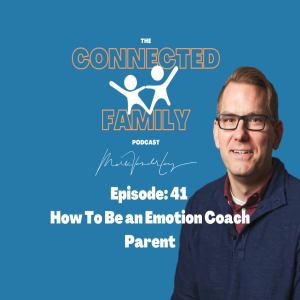
Monday Dec 14, 2020
How To Be an Emotion Coach Parent
Monday Dec 14, 2020
Monday Dec 14, 2020
Host Mark Vander Ley Ph.D., LCPC discusses the four styles of parenting identified by Dr. John Gottman's research. The four styles of parenting described in "Raising an Emotionally Intelligent Child" are The dismissing parent, the disapproving parent, the Laissez-Faire parent and the emotion coach parent. This episode of The Connected Family Podcast focuses on describing the four types of parenting style and then summarizes the five steps of emotion coaching.
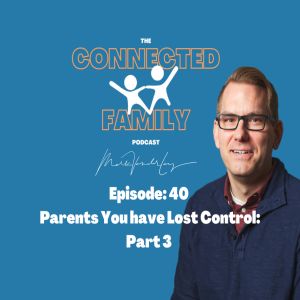
Monday Dec 07, 2020
Parents You Have Lost Control: Part 3
Monday Dec 07, 2020
Monday Dec 07, 2020
Parents You have Lost Control: Part 3
Every family needs an established set of limits. Predictable limits help children feel protected and challenged. They are designed to ensure safety and to allow for exploration. Consistent limit-setting may be the most difficult part of a parent’s job.
Loving
Limits are loving and compassionate when set by parents. Although it can be difficult, and some children may claim that their parents hate them when they set them, limits provide structure, support, and guidance that a child needs to feel safe.When set in a calm and empathetic manner, limits provide the basis for a child’s future identity development.
Instructive
Limits are instructive, and parents are not. It is tempting for parents to “preach” when setting limits, so as to be sure that the child understands the lesson. However, the real teacher is the limit. Children learn best through experience, and a consistently set limit will teach a lesson even if a child has tuned out the voice of a parent.
Meaningful and Manageable
Limits serve a purpose and are simple enough that parents can follow through on them with moderate effort. First, the set limit should be directly related to the offense. For example: if homework goes unfinished, then Billy will not be able to watch TV tonight. The limit should cause some level of anxiety for the child. Sending them to their room with TV, video games, and internet probably will not cause anxiety. Additionally, the limit should not overwhelm parents. For example, grounding a busy teen from the car for a year will cause too much disruption to the family routine, and parents will not likely be able to enforce the grounding.
Individual
An important limit for one child may not be important for another. Every child is different, and parents should adjust their parenting approach based on the needs of the child. Age is an important factor as well. A teenager can handle more freedom to choose than an eight year old. As a child matures and grows, they should be able to earn more freedoms.
Timely
Limits should be set in appropriate time. For a young child, the enforcement of the limit must be very close in time with the offense. For a teen, however, delaying the limit so that mom and dad can discuss it together can actually raise the level of anxiety and increase the effectiveness of the limit.
Safe
Limits must be emotionally safe. A parent must be in control of their emotions while setting a limit. A parent that is visibly angry and upset while setting a limit cannot think clearly enough to set appropriate limits. This parent is also in danger of producing fear in the child rather than anxiety. Fear produces external motivation, which is not the goal of limit-setting. What we desire to produce is internal motivation, which is produced by anxiety
One of the hardest parts about learning of setting limits is deciding what level of freedom, both emotional and physical, is appropriate for your child. Obviously a toddler has narrower limits than a teenager who has begun to demonstrate personal responsibility. The most important piece of setting limits is allowing enough freedom of exploration and experimentation so as to provide the child with the feeling of competence, power, confidence, and excitement. But, you do not want to allow so much freedom that the child does not learn to respect the rules of nature and authority. The optimum level of freedom provides enough challenge for the child to master increasingly difficult skills and enough limits for the child to be safe and respectful. In this next exercise, I challenge parents to sit down with one another and access what LIMITS will be for their house in the current stage. It is recommended that families re-evaluate household LIMITS for each developmental stage (infant, toddler, preschooler, elementary, Jr. High, High school).

Sunday Nov 29, 2020
Parents You Have Lost Control: Part 2
Sunday Nov 29, 2020
Sunday Nov 29, 2020
Parents You Have Lost Control: Part
I have many discussions with parents that center around the issue of control. The surprising part for many of them is that I emphasize giving up control rather than maintaining control. It seems to me that parenting is a life-long exercise in gradually giving over more and more control to our very precious children. This process can be a very scary, or even painful, endeavor for many parents, especially when it is done either too quickly or too slowly. Many parents wonder, “If I give up control to my child, then how will he learn what is right?” or “Won’t they end up being wild children who are continually in trouble?” Though it is tempting for some parents to believe that gradually giving control over to their children will result in ineffective or poor behavior, the truth is that giving age-appropriate control to our children is actually in their best interest. In reality, giving more control to your children as they mature will help develop a confident, internal moral compass from which they will make better decisions on their own..
Let’s make the distinction between being “in control” and being “controlling.” Chris Mercogliano in his book “In Defense of Childhood Protecting Kid’s inner wildness.” Describes “in control” as “establishing age appropriate limits, while at the same time supporting children’s growing sense of autonomy by allowing them to make choices and learn from their mistakes” (pg. 9). Being “in control” is setting very clear limits for children and enforcing those limits consistently. However, if a child is moving within those limits, he is free to be in control of his decisions and behavior. The approach of the “in control” parent allows children to practice making choices that meet their needs or desires, but provides appropriate limitations to that freedom. Alternatively, Mercogliano describes “controlling” as “placing high value on obedience, shepherding children toward specific outcomes, and discouraging verbal give and take” (pg. 9). A controlling parent is not only setting limits, but is active within those limits, making choices and decisions for a child that he could have easily made on his own. A controlling parent who is focused “toward specified outcomes” has his own ideas for the child and is out to make them happen. This parent does not consider the child’s desires, interests, or skills. Instead, this parent’s focus is on meeting his or her own needs.
The key is to gradually give age-appropriate control to our children, which is given in the form of choices. For example, you may ask your young child, “Would you like to wear shorts or blue jeans today?” or “Would you like to drink milk or water?” or “Do you want to read books or play outside?” All of these choices are opportunities for parents to give children control over the moments of their lives without allowing them to be in control of the household. We have all seen the three year old who is clearly in control of the parent-child relationship. Instead of being given choices chosen by the parent, this child is dictating the agenda for the entire household. Giving a young child too much control is not only unhealthy, but is also harmful for future development. On the other hand, giving age-appropriate choices to our children boosts their healthy development.
The most important aspect to remember when offering choices to your child is that you must be comfortable with all the choices given. As a parent, you have to be willing to follow through on your child’s choice, so offer these choices carefully. For example, giving a three year old the choice between riding his tricycle in the driveway and riding his tricycle around the block unsupervised is not acceptable. Once you begin to offer choices to your child, it will become second nature. You will begin to see everything as a choice and will learn how to phrase things as opportunities for choices rather than commands.
So, what good does offering all these choices do? Children who have been raised with appropriate levels of control in their own life grow to be teens who are intrinsically motivated. All the millions of choices that they have been allowed to make over their lives have taught them that they have the power and ability to make their life what they want it to be. These children have what is referred to as an internal locus of control. They believe that the outcomes of their actions are the function of their effort, skill, and personality. They are confident in their abilities to succeed, and motivation for that success comes from within. In fact, “allowing children the freedom to pursue their interests without interference is paramount for intrinsic motivation” (Mercogliano, pg 10). However, a controlling parenting style leads towards children who have an external locus of control. These children have been so controlled from the outside that they do not know how to make decisions without outside help. They believe that they have very little power to make life what they want it to be. They are waiting for someone to come along and do “it” for them, or are hoping for a miracle to make their dreams come true. Those with an external locus feel as though they are not responsible for the outcome of their actions.
Giving up control also allows our children to internalize their values. Parents desire to see their children make decisions that are based on their value system. It is sad to see a child who makes decisions based on the desires of his peer group or cultural influences. A responsible child is one that makes right decisions because he is confident in his values and view them as more important than the applause of peers. Internalized values are a very important part of identity development, as what we value contributes greatly to our thinking. And when our thinking is deeply rooted in our values, our behavior usually lines up. The positive result is an integrated identity.
Finding a healthy balance in the amount of control we give to our children is difficult, but so important. Remember, a child with too much control is no better off than one with not enough control. I encourage parents to start small. Give your child control over as many things as possible while maintaining appropriate limits. Having clear limits for your child will help to balance the temptation to over-control. As long as the child is within the clear limits, he is free to behave and choose as he wishes. When he wanders outside the limits, make sure he experiences a consequence that reinforces the limit.
In summary, a gradual release of control to your child will help him to grow into a teen that believes that the outcome of his actions is a function of effort, skill, and personality. Giving up control will also foster the internalization of a child’s values, which is a key component to the development of an integrated identity. Over-control by parents will leave teens with a sense that they are not responsible for the outcome of their actions. They will also be susceptible to the influence of peers and culture in regards to decisions about values and conduct.
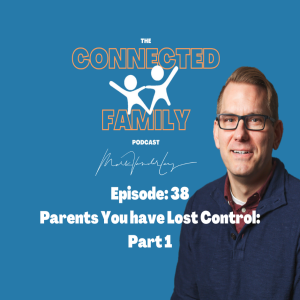
Sunday Nov 22, 2020
Parents You Have lost Control: Part 1
Sunday Nov 22, 2020
Sunday Nov 22, 2020
Parents You have Lost Control Part 1
My wife and I are in serious trouble! Today my five year old discovered the most well kept and important secret of the parenting world. I was hopeful that my boys would not discover this secret for several more years. Now that the middle child has figured it out however, it will not be long before the other three catch on.
He has discovered that when it really comes down to it, I cannot MAKE him do anything.
We stopped at a local restaurant to grab dinner following his soccer game. I was rushing home to pick up his older brother so that I could take him to his cub scout meeting. As we left the restaurant he stopped, just outside the door. I was walking ahead of him and looked back to see him propped up against the wall scraping his soccer cleats on the ground. I said, “come on buddy, let’s go” He said, “No” and just stood there. He looked at me with a knowing smirk; he saw that my hands were full, I was in a hurry, and that I had few parenting “tools” at my disposal.
Thankfully, I had gotten off work a little early today so I was in a pretty patient frame of mind. I remained calm and began racking my brain for the best way to handle this situation. We stood there looking at one another for nearly a minute. It began to feel like the stand off at the OK corral, whoever moved first, was doomed to lose. After searching for the most helpful tool in my bag for this situation, I came up empty. I was unable to think of a logical or enforceable statement to convince him that he should move on his own. So, I walked back to where he stood, took his arm and walked him to the car. Eventually he decided to walk on his own, and climbed into his seat.
As I reflect on this situation I am struck by the simple truth, I CANNOT MAKE HIM DO ANYTHING. At this point he is only five, I am bigger than he and I can take him by the arm and walk him to the car. In ten years if he decides to take a similar approach about going to school things will be different. I will not be able to physically move a fifteen year old as I did my five year old today.
This was a power struggle, he realized that I was in a hurry and short handed; he decided he was going to exercise his personal will. I am reminded of how important it is for parents to admit and be OK with the fact that we cannot MAKE our children do anything. All we can do is state what we are going to do. We cannot control our children, instead we must explain the expectations or limit and then manage our own responses accordingly. When the child does not meet the expectation the parent can let go of forcing him to “do” something and provide a logical consequence for the decision. If the child meets the expectation he learns a lesson about responsibility, if the child does not meet the expectation and experiences a consequence, he learns a lesson about responsibility. Either way the lesson is learned and the parent maintains sanity by understanding, “I don’t have to control my child, only my self.”

